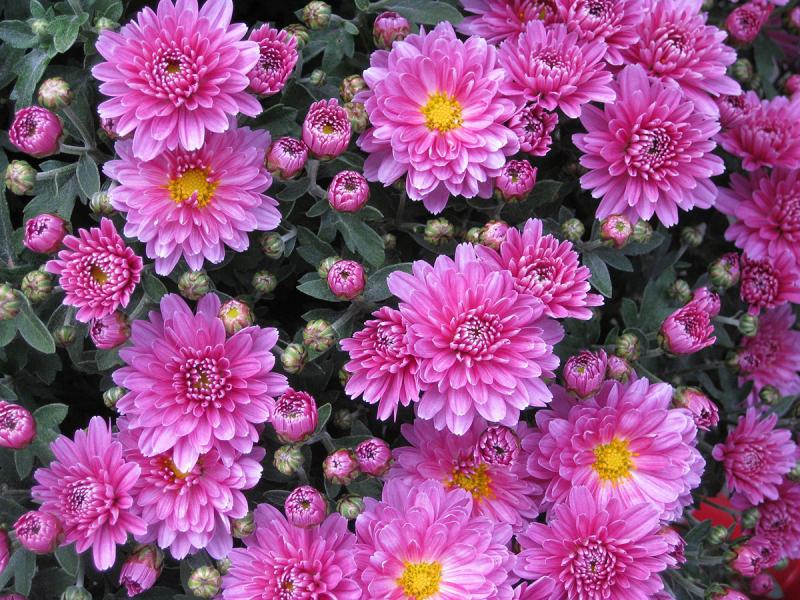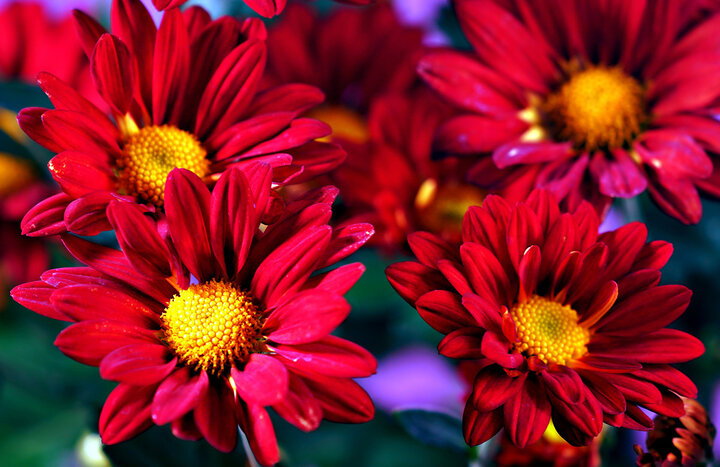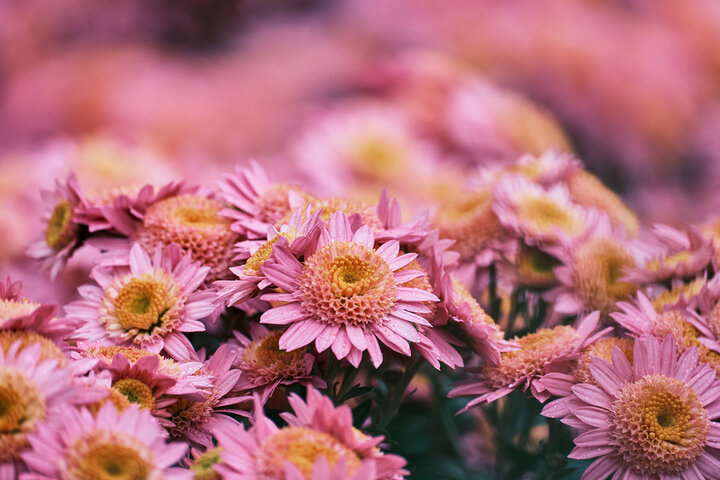Sarah Browning, Nebraska Extension Educator

Cushion mums have double flowers on rounded plants usually two feet tall or shorter. Pictures by Pixabay.
Mums are the stars of the fall perennial garden. They bloom profusely and continue blooming even after frosts have zapped tender annual flowers. They are now available at garden centers in a wide range of colors including white, yellow, orange, bronze, red, purple and pink. “Chrysanthemum” is now a common name for this large group of plants. The most widely planted mum, the fall garden mum, is known botanically as Dendranthemum x grandiflorum.
Fall is a good time to select mums because you can see firsthand what each variety has to offer. You can buy plants in bloom and simply pop them into sunny spots in the garden for instant and continuing enjoyment. You can also plant flowering plants in the spring or rooted cuttings.

Chrysanthemum Types
Mums are classified by flower shape. Some of the most common types include daisy, anemone, pompon, cushion and button mums.
- Daisy mums have daisy-like flowers with 1-5 rows of long petals radiating from a flat, central, yellow “eye”.
- Anemone mums are similar to daisy mums, but have a rounded crest of deeper colored, short petals in the center instead of a central “eye”.
- Pompon mums have stiff, almost globular double flowers with no central daisy-like eye, on plants less than 18 inches tall.
- Cushion mums have double flowers on rounded plants usually two feet tall or shorter.
- Button mums have small double flowers on plants less than 18 inches tall.
Mums vary widely in cold hardiness. Floral mums, sold by grocery stores and florists year-round usually do not survive Nebraska winters, and if they do they may not bloom quickly enough before flower buds are damaged or killed when a hard fall frost occurs.

Growing Mums
Chrysanthemums are adaptable to many soils types, but the soil must be well-drained due to their relatively shallow root systems. In poorly drained soils, soil-borne diseases may injure plants during wet summer periods resulting in root rots, while winter injury is likely if water stands around the crowns of plants during winter thaws. After planting, any depressions around your plants that might collect water should be leveled.
Chrysanthemums are most showy when planted in masses or small groupings. Choose a full sun location and place mums 15-24 inches apart. Each plant’s root ball should be slightly below ground level, with the soil firmed gently around the roots.

After planting, water thoroughly to settle the soil around the plant. Thereafter, water the plants well once a week while they are still growing. More frequent watering may be required on sandy soils or when temperatures get hot.
When planting mums in the fall, allow at least six weeks of good growing weather for them to establish their root system before winter. Otherwise, plants may be prone to winter injury.

Apply 3-4 inches of mulch around the plant’s crown to provide some protection from frost heaving by moderating soil temperature fluctuations. In the spring, remove about half the winter mulch in early April and loosen the rest. Finish removing the excess winter mulch in early May, but allow a couple inches to remain for summer to suppress weed growth and conserve soil moisture.
Troubleshooting
Problems commonly found with mums include winter injury if non-hardy varieties are grown or if plants desiccate (dry out) during the winter.
Plants grown in shade or semi-shady locations tend to grow taller (be leggy), have weaker stems and smaller flowers, and fewer blooms. So start off right by locating them in a sunny spot!
A common question with tall, leggy chrysanthemums is when to stop pinching them back. “Pinching” or removing the top ½ to one inch of each strong terminal shoot helps to develop a well-branched, rounded plant. Pinching should be done 2 or three times, starting in early summer when plants are five to six inches high and ending around mid-July.
Late flowering of mums may be caused by using an inappropriate cultivar, insufficient sunlight, excess fertilizer, too much or too little water and late pinching. Root competition from nearby trees, unusually hot weather in August, or insect and/or disease injury also may delay flowering.
Good luck with your mums this fall and enjoy that "pop" of color.
Images by Pixabay. Feature image - cushion mums have double flowers on rounded plants usually two feet tall or shorter.
- Button mums have small double flowers on plants less than 18 inches tall.
- Daisy mums have daisy-like flowers with 1-5 rows of long petals radiating from a flat, central, yellow “eye”.
- Anemone mums are similar to daisy mums, but have a rounded crest of deeper colored, short petals in the center instead of a central “eye”.
- Pompon mums have stiff, almost globular double flowers with no central daisy-like eye, on plants less than 18 inches tall.
Search Our Archive
Associated Video
Green & Growing Tip - Pinching & Deadheading
UNL Extension Educator Sarah Browning demonstrates pinching back and deadheading